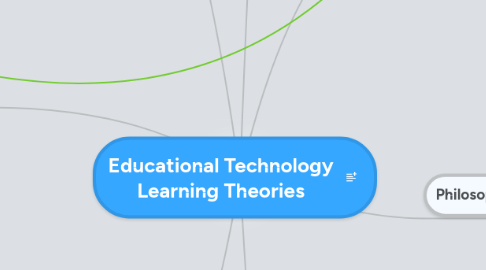
1. Media Ecology
1.1. Key Ideas
1.1.1. The medium is the message
1.1.2. High and low involvement media
1.1.3. Media Ecology Association
1.1.4. Communication is more convenient and efficient through technology
1.1.5. Technology influences our society today
1.2. Definition
1.2.1. How the media affects perception, understanding and feelings of individuals
1.2.2. Study of media in various environments
1.3. Key Theorists
1.3.1. Neil Postman
1.3.1.1. Media structure
1.3.1.2. Roles that media play in society
1.3.1.3. Assigns roles to individuals and how they play them
1.3.1.4. How media influence the way individual's act
1.3.2. Mcluhan
1.3.2.1. The media changes the way people communicate in society
1.3.2.2. Communicate in words in order for it to be sent
1.3.2.3. Different variety of prints (alphabet) determines what kind of communication is sent
2. Social Construction of Technology (SCOT)
2.1. Key Ideas
2.1.1. Connection between social and technical processes
2.1.2. Understand human constructions
2.1.3. Link individuals to social processes
2.1.4. It doesn't determine human actions, but human action shapes technology
2.2. Criticism
2.2.1. It emphasizes the social and importance of the physical world
2.2.2. Viewed as a social determinism
2.3. Significant Theories
2.3.1. Symmetry: Success and failure is explained through technology developments
2.3.2. Bicycle: The focus of problems that influence this bicycle theory
3. TPACK
3.1. Basic Principles
3.1.1. Teachers must know
3.1.1.1. Content
3.1.1.2. Pegagogy
3.1.1.3. Technology
3.1.2. Once teachers begin teaching in classrooms, they will slowly build on their ways of teaching in order to deliver the information to the students more effectively
3.1.3. TK: Technology knowledge states the knowledge of various types of technology tools that can be integrated into teaching and how it can impact a student's learning
3.1.4. TCK: Technology content knowledge states how technology can teach content in different approaches
3.1.5. TPK: Technology and pegagogy knowledge states that knowledge constraints different teaching approaches
3.1.6. TPCK: How technology, pegagogy and content knowledge mesh together to balance out the importance of what a teacher needs to know when it comes to effective teaching
3.1.7. TPACK Application
3.1.7.1. Teacher Professional Development
3.1.7.2. Lesson Plan Evaluation
3.1.7.3. Teacher Education
4. Behaviourism
4.1. Key Ideas
4.1.1. Cuing
4.1.2. Drill and practice
4.1.3. Modelling: Model ways in order for students to use technology
4.1.4. Shaping: Teachers gives students feedback and advice so they can improve in their students
4.2. Key Theorists
4.2.1. B.F Skinnier
4.2.1.1. Operant Conditioning: Changing behaviour by the use of reinforcement that is given after a responce
4.2.1.2. Skinner box Theory
4.2.1.3. Study observable behaviour than internal mental events
4.2.1.4. Came up with Positive Reinforcement (providing a consequence an individual finds rewarding) and Negative Reinforcement (removal of an adverse stimulus)
4.2.1.5. Punishment
4.2.1.5.1. It works by applying an unpleasant stimulus or a rewarding stimulus
4.2.1.5.2. Opposite of reinforcement
4.2.2. John Watson
4.2.2.1. Opposed mentalistic approaches
4.2.2.2. Practice will strengthen learning
4.2.2.3. Rejected individual differences
4.2.2.4. Human differences are the result of learning
4.2.3. Ivan Pavlov
4.2.3.1. Classical conditioning builds on reflexes (unconditioned stimulus and an unconditioned responce)
4.2.3.2. Pavlov's dogs
4.2.4. Edward Thorndike
4.2.4.1. Law of Effect: Responces that produce a satisfying effect will most likely occur again in the situation
4.2.4.2. Law of Exercise: The strength at which the responce will be connected depends on the number of times it occurred in the particular situation
4.2.4.3. Introduced the Stimulus-Responce Theory
4.3. Behaviourist Technologies
4.3.1. iClickers
4.3.2. Math games
4.3.3. Online tutorials
4.3.4. Youtube videos
4.4. Criticism
4.4.1. Our minds are not a blank state
4.4.2. People adapt
4.4.3. Learning doesn't always connect to behaviour
4.4.4. Learning doesn't require punishments
5. Cognitivism
5.1. Key Theorists
5.1.1. Jean Piaget
5.1.1.1. Stages of Development
5.1.1.2. Schemas are the basic building blocks of knowledge
5.1.1.3. Concepts of assimilation, accomodation and equilibrium that enables the transition from one stage to another
5.1.2. J.S Bruner
5.1.2.1. Transfer of knowledge
5.1.2.2. Interested in the material to be learned is the best stimulus to learning
5.1.2.3. People use their prior knowledge of what they already know and apply it to real life situations
5.1.3. L.S Vygotsky
5.1.3.1. The Zone of Proximal Development
5.1.3.2. Connection between social connection and thought
5.1.3.3. Teachers and parents are there to support a child's learning
5.2. Key Ideas
5.2.1. Schemas
5.2.2. Motivation
5.2.3. Organization
5.2.4. Memory devices
5.2.5. Prior knowledge is significant in learning
5.2.6. Beyond the blank state of an individual's mind
5.3. Cognitive Load Theory
5.3.1. Information that can be processed over and under the load working memory
5.3.2. Chunking ideas
5.3.3. Instructional design
5.3.4. Learning structures
5.4. Cognitivist Technologies
5.4.1. Prezi
5.4.2. Databases
5.4.3. Mindmeister
5.4.4. Electronic note taking
5.5. Criticisms
5.5.1. Too focused on knowledge
5.5.2. Ignores the psychomotor
6. Constructivism
6.1. Constructivist Technologies
6.1.1. Video games
6.1.2. Google sites
6.1.3. Wordpress
6.1.4. Blogger
6.2. Key Ideas
6.2.1. The mind is like a network
6.2.2. Learning is all about building connections with others in an environment
6.2.3. Vygotsky's Zone of Proximal Development
6.2.4. Teachers and parents are supportive people
6.2.5. Learning involves an individual's knowledge that is based on their own life experiences
6.3. Criticisms
6.3.1. Very time consuming
6.3.2. Difficult assessment
6.3.3. Lack of research
6.3.4. Subjective learning
7. Philosophy of Teachnology
7.1. Basic Principles
7.1.1. Philosophy of teaching: Beliefs about one's individual teaching practices
7.1.2. An individual's belief about how technology should be incorporated into classroom teaching practices
7.1.3. Technology in the classroom can enhance an individual's learning to strive for better grades
7.1.4. Every teacher has their favourite web tools that helps students communicate and make learning more enjoyable
